By Ruchika Gupta
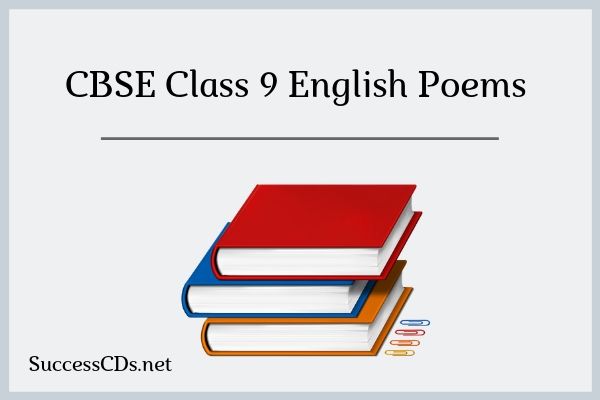
Here, the summary, explanation, word meanings, poetic devices of all the poems of CBSE NCERT Class 9 English Beehive book have been compiled for the convenience of the students. This is a compilation of extensive notes of all the poetry from the Beehive book for CBSE NCERT Class 9 English . The explanation and summary have been done in an easy language so that every student can understand.
Poem 1 – The Road Not Taken by Robert Frost
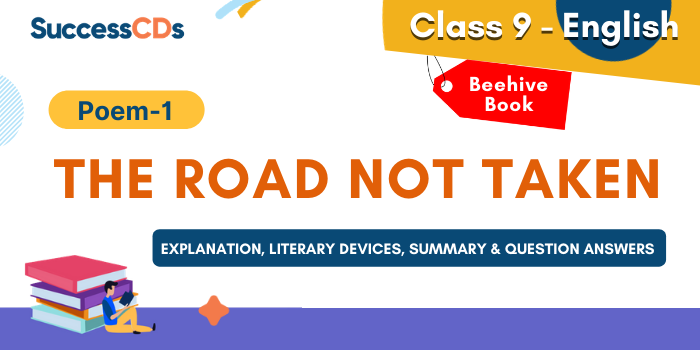
This well-known poem is about making choices, and the choices that shape us. Robert Frost is an American poet who writes simply, but insightfully, about common, ordinary experiences
See Video for Explanation and Summary of the Lesson
Introduction to the poem
In the poem – ‘The Road Not Taken’, the road symbolizes our life. The poet says that the path that we don’t choose in our life is ‘the road not taken’. He describes his feelings about that choice that he had left in the past. The path which we have chosen, decides our future, our destination. The important message that the poet wants to give is that the choice that we make has an impact on our future and if we make a wrong choice, we regret it but cannot go back on it. So, we must be wise while making choices.
Poem and Explanation
Stanza 1
Two roads diverged in a yellow wood,
And sorry I could not travel both
And be one traveller, long I stood
And looked down one as far as I could
To where it bent in the undergrowth;
diverged: separated and took a different direction
yellow wood: a forest with decomposing leaves
undergrowth: dense growth of plants and bushes means the forest)
Once the poet was walking down a road and then there was a diversion, there were two different paths and he had to choose one out them. The poet says that as he was one person, he could travel on one road only. He had to choose one out of these two roads. (Yellow wood means a forest with leaves which are wearing out and they have turned yellow in colour – the season of autumn.) Yellow woods represent a world which is full of people, where people have been living for many years. They represent people who are older than the poet. The poet kept standing there and looked at the path very carefully as far as he could see it. Before taking the path, he wanted to know how it was- was it suitable for him or no. He was able to see the path till where it curved after which it was covered with trees and was hidden. It happens in our life also when we have choices, we have alternatives, but we have to choose only one out of them, we take time to think about the pros and cons of each, whether it is suitable for us or not and only then, we take a decision on what path we should choose.
Stanza 2
Then took the other, just as fair,
And having perhaps the better claim,
Because it was grassy and wanted wear;
Though as for that the passing there
Had worn them really about the same.
fair: As good as the other one,
claim: Better option
grassy: unused
wanted wear: had not been used
The poet kept on looking at one path for a long time to check if it was the right path for him or not and then, he decided and started walking on another path because he felt that both the paths were equally good. He says just as fair, so, he felt that both paths were equally good and started walking on one of them. He adds that maybe he felt that the path was better for him so he chose it as it had grass on it which means that it was unused. Not many people had walked on this path earlier that is why this path was grassy. ‘And wanted wear’ means that it was not walked over by many people. After he walked on the path for some distance, he realized that both the paths had been worn out the same way. Both the paths were similar and worn out. Even in our life, we take any path or option but all of them have the same benefits, disadvantages, problems, challenges and we must face them. We think that we are choosing a better option, but it is not that way.
Stanza 3
And both that morning equally lay
In leaves no step had trodden black.
Oh, I kept the first for another day!
Yet knowing how way leads on to way,
I doubted if I should ever come back.
trodden means walked over.
The poet says that both the paths were similar that morning. Both had leaves on them and no one had stepped on them as they were still green in colour. He decided that that day he would take one path and keep the other path for another day, although he knew that one way leads on to another way. He knew that he could not go back on the choice that he had made. Similarly, even in our life, once we choose an option, we must keep on moving ahead with that option and we never get a chance to come back and take the other option that we had left earlier.
Stanza 4
I shall be telling this with a sigh
Somewhere ages and ages hence;
Two roads diverged in a wood, and I —
I took the one less travelled by,
And that has made all the difference.
sigh: deep breath
hence: here, in the future
He says that in the future, he will take a deep breath and say that once upon a time, he had reached such a point in life that there were two options for him and he travelled on that road which had been travelled by lesser number of people. That decision of his made his future. Similarly, in future, when you grow up, then you will say that once upon a time, when you were young, you had two options. The choice that you made, made you what you became of it.
This is a very strong message for all the students – that you should be wise and be careful while making choices out of the options that you have in your life because your future depends on the choice that you make today.
Literary Devices
1. Rhyme Scheme: abaab
2. Symbolism: two roads which represents two or more choices in our life
3. Anaphora: ‘and’ repeated at the beginning of lines 2, 3 and 4
4. Alliteration: Wanted Wear ‘w’ sound is repeating
i) ‘first for’ – ‘f’ sound is repeating
ii) ‘though, that’- ‘th’ sound is repeating
5. Repetition: ‘Ages’ is repeated. ‘Two roads diverged in a wood’- this sentence is repeated in stanzas 1 and 4.
Summary
The poet says that once, he was walking down the road and reached a fork. He could walk over one of the paths only. He took time to choose the right path. He inspected them to decide which was a better option and then chose the one which seemed less walked over. He kept the other one for some other day although he knew that he would never get the chance to walk over it. He would go further on the chosen path and not get a chance to go back on it. As he walked on the chosen path, he realized that both the paths were similar. He felt that his future depended on the choice that he made.
Question and Answers
1. Where does the traveller find himself? What problem does he face?
A. The traveller finds himself standing on a fork in the path. He is in a problem as he must choose one path and is unable to decide which one to choose.
2. Discuss what these phrases mean to you.
(i) a yellow wood
A. ‘Yellow wood’ refers to the forest which has withering leaves as in the season of autumn. It represents a world full of aging people.
(ii) it was grassy and wanted wear
A. It means that the path had a lot of grass on it. This means that it had not been walked over by many people. It had to be worn out by the steps of the people who walked on it.
(iii) the passing there
A. It means that when he walked over the path that he had chosen.
(iv) leaves no step had trodden black
A. It means that no one had walked over the leaves as they were still green. If they had been walked over, they would have turned black.
(v) how way leads on to way
A. It means that as we walk on a path, we come across more options and make choices further. We keep on walking ahead on that way.
3. Is there any difference between the two roads as the poet describes them
(i) in stanzas two and three?
A. The two paths were similar. In the beginning, the poet felt that one of them was grassy and had not been walked over by many people, but when he walked on it for some distance, he realized that it was like the other road.
(ii) in the last two lines of the poem?
A. Here, again the poet talks of his initial decision when he thought that the roads were different and chose the one that had been walked over by a lesser number of people.
Poem 2 – Wind by Subramania Bharti
[Translated from Tamil by A.K. Ramanujan]
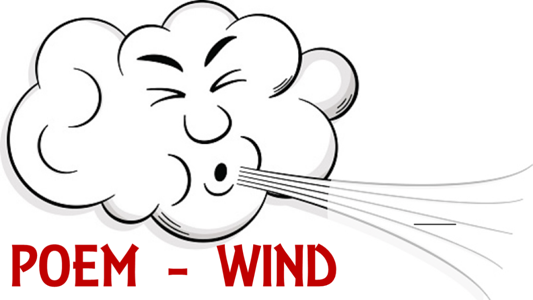
-
Introduction to the Poem
We all know that wind is a natural phenomenon. In this poem, the poet talks to the wind. The power of wind has been described and the poet says that wind is destructive. He has linked the destructive power of wind to the adversities of life and says that the weak people break down, but stronger people emerge out of adversities, stronger. The poem gives an important message that we should be mentally tough and physically strong in order to survive the hardships of life. A weak person breaks down like a weak building and crumbles. We must make these destructive forces our friends, with our strength and determination.Poem and Explanation
Wind, come softly.
Don’t break the shutters of the windows.
Don’t scatter the papers.
Don’t throw down the books on the shelf.
There, look what you did — you threw them all down.
You tore the pages of the books.
You brought rain again.
You’re very clever at poking fun at weaklings.poking fun: making fun of something
weaklings: a person who is weakThe poet is talking to the wind. He asks the wind to come softly. So, he is saying that the wind should not be very strong, loud. It should be soft and subtle. Then he says that the wind is very powerful it is destructive, it breaks the shutters of windows and scatters the papers. When the wind is very powerful, all the books which are kept on the shelf fall down. So here, the poet is describing the power of the wind. Then he says to the wind to look at the destruction that it had done. Whenever there is a strong wind all the thing that are weak, like small plants, tiny children, etc., they all get scared and they can even fall and get hurt. We can say that in the initial part of the poem, the poet is referring to wind as a young child. He is saying that it should come softly just like a small child does. In the later part, we come to know that the wind is destructive just like a youth. Just like a young boy or a young girl who is full of energy, violence and destruction.
Frail crumbling houses, crumbling doors, crumbling rafters,
crumbling wood, crumbling bodies, crumbling lives,
crumbling hearts –
| Class 9th English Lessons | Class 9th English Mcq | Take Class 9 MCQs |
| Class 9th Hindi Lessons | Class 9th Hindi Mcq | Take Class 9 MCQs |
| Class 9th Science Lessons |
crumbling: falling or to cause something to break
rafter: sloping beam which support the roof of the building
Here, the word ‘Crumbling’ is repeated so many times to lay stress that everything crumbles in the face of a strong wind. So, the writer is saying that when wind is very powerful, it is very strong, it leads to breakage of everything. Houses which are weak, fall, doors which are weak fall, the beams on which the roof of the buildings are supported, they also fall, all the wooden structures fall, all bodies of people fall, animals, lives, hearts. So, he is saying that everything crumbles. Everything that is weak reacts by falling down and breaking in the face of adversity. So, the poet is saying that whenever a weak person faces any adversity or challenge in life he breaks down and falls.
the wind god winnows and crushes them all.
winnows: to broke grain free of chaff, separate grain from husk by blowing on it.
The poet is addressing wind as ‘wind god’, and he is saying that the powerful god of wind winnows, that means he sifts all the people and those people who are weak fall down and get crushed. So here, a comparison is made between wheat and people. Just like we winnow the wheat to separate the grain from chaff, the wind god separates the strong people from the weak people. When there is a strong wind, all the things that are weak fall and get crushed.
He won’t do what you tell him.
So, come, let’s build strong homes,
Let’s joint the doors firmly.
Practice to firm the body.
Make the heart steadfast.
Do this, and the wind will be friends with us.
steadfast – firm
The poet wants us to make friends with the wind i.e. the adversities in our lives. He says that the problems will not listen to us. They will come, so we should be prepared. In preparation, we should build strong homes and close the doors of our house firmly so that the wind cannot get into. And then he says that we should also make our bodies strong and hearts firm to face these challenges. And then once we are strong enough all the challenges will be like friends. We will not feel that they are troublesome.
The wind blows out weak fires.
He makes strong fires roar and flourish.
His friendship is good.
We praise him every day.
flourish: grow
The poet has kept the wind on a pedestal. He is comparing the wind to god. He says that wind is god and we praise wind every day. He adds that everything that is weak gets finished off in the face of the strong wind. And all the things that are strong, flourish and grow to become stronger. He is giving us a very important message, that we should not feel bad that we are facing so many challenges and adversities in life. We should make our self physically and mentally strong to face these challenges. And once we are strong enough, we will overcome the challenges, we will become friends with them and then we will be happy that we had these challenges in our life because they help us become stronger and better.
Literary devices in the poem
Rhyme scheme – The entire poem is written in free verse. There is no rhyme scheme in the poem.
The literary devices used are as follows –
1. Anaphora – When a word is repeated at the start of two or more consecutive lines, it is the device of Anaphora.
Lines 2, 3, 4 begin with ‘don’t’.
Lines 6, 7, 8 begin with ‘you’.
2. Personification – wind has been personified. When the poet says ‘you are’, he is referring to wind as ‘you’ that means he is treating wind as a person.
3. Repetition – ‘crumbling’ is repeated many times to lay emphasis. The poet wants to say that the wind crushes everything that is weak. That is why he repeats the word crumbling.
4. Alliteration – the repetition of a consonant sound in close connection. ‘wind winnows’.
‘won’t want’
5. Symbolism – Symbolism means that the thing refers to some other thing. wind is a symbol. It refers to the challenges in life. He is using wind as a symbol for the adversities in our life.
Summary
The first part of the poem describes the action of the wind. The poet asks the wind to come softly. He requests the wind not to break the shutters of the windows, not to scatter the papers and throw down the books from the shelf. But the wind throws the books and tears the pages. The poet says that the wind makes a mockery of weaklings. It brings down frail houses, crumbling doors, rafters, and even weak hearts. It crushes everything that is weak.
The poet advises us to be strong. Only then can we save ourselves from the wind. We should build strong homes with firm doors. Our bodies and hearts should also be strong. It is the way of the world to kick the weak and to be friends with the strong. The wind blows out the weak fires but makes the strong fires roar and flourish. Thus, the poem conveys the idea that nobody cares for the weak. Even the wind is on the side of the strong people. We must make ourselves strong to become successful and overcome the challenges in life.
Question and Answers
1. What are the things the wind does in the first stanza?
A. When the wind blows violently, it destroys everything. It breaks the shutters of windows, scatters the papers, throws the books down from the shelves, tears their pages and brings along a lot of rain.
2. What does the poet say the wind god winnows?
A. The wind God winnows means that nature sifts the weak things from the strong ones. Everything that is weak is tossed by the powerful wind and gets destroyed. Just like the winnower separates the grains of wheat from the chaff, similarly, the wind god separates the weak from the strong.
3. What should we do to make friends with the wind?
A. We must make ourselves strong to face the violent wind. When we will be strong, the wind will not harm us, instead it will become a friend and help us to grow and flourish.
4. What do the last four lines of the poem mean to you?
A. The last four lines of the poem carry an important message that the strong people emerge stronger and victorious in the face of adversities. We must make ourselves strong like a burning fire which grows and flourishes in the violent wind, we also prosper in the face of challenges.
Poem 3 – Rain on the Roof by Coates Kinney
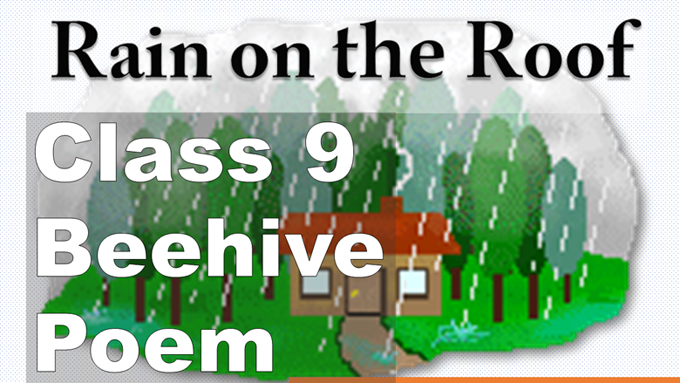
Introduction to the Poem
From the title of the Poem- ‘Rain on the Roof’, we can make out that the poem is about the rain. The poet is telling us about the memories he has of the rain. The sound of the raindrops falling on the roof of his house brings back sweet memories of the past.
Poem and Explanation
Stanza 1
When the humid shadows hover
Over all the starry spheres
And the melancholy darkness
Gently weeps in rainy tears,
What a bliss to press the pillow
Of a cottage-chamber bed
And lie listening to the patter
Of the soft rain overhead!
Humid: something which is full of moisture.
‘shadows’ refers to the moisture laden clouds which cast a shadow on the earth.
hover: Move around something
melancholy: sad
bliss: Happiness
patter: sound of raindrops falling on the roof.
Cottage chamber means the bedroom.
The poet is saying that when the humid shadows hover (here, ‘humid shadows’ refers to dark clouds which are full of water). The poet is saying that when the sky is full of these clouds which are moisture – laden, are full of water and are about to bring rain, when such clouds hover around in the sky, over all the starry spheres (‘starry spheres’ refers to the sky at night time which is full of stars). At that time, huge clouds which are full of moisture, move around in the sky and the sad darkness of the night is wiped off by the raindrops which seem like tears falling from the sky. The poet is comparing rain drops to tears and he says that the dark sky which seems to be very sad, it appears as if it is crying and the raindrops are the tears shed by it. He adds that it is a like a blessing to lie on the bed in his room (Cottage chamber means bedroom) and listen to the sound made by raindrops falling on the roof.
Stanza 2
Every tinkle on the shingles
Has an echo in the heart;
And a thousand dreamy fancies
Into busy being start,
And a thousand recollections
Weave their air-threads into woof,
As I listen to the patter
Of the rain upon the roof.
tinkle: short, light ringing sound
shingles: rectangular wooden tiles used on roofs
echo: repeated sound
woof: weft, i.es the thread woven across the loom
patter: sound of raindrops falling on the roof
‘busy being’ refers to human beings and here, the poet is referring to himself
The poet is expressing his feelings when he hears the raindrops falling on the roof top of his house. He says that every tinkle on the shingles has an echo in the heart. Whenever he hears rain falling on the roof top, the sound repeats in his heart and in his dreams, he has many different, fanciful imaginations. He adds that this sound of the rain falling on the roof top creates many new different dreams in his mind. He recollects many memories of the past which come back into his mind as dreams. So, he says that as he listens to the patter of the rain upon the roof, he has many new dreams in his mind and the memories of the past come back in the form of dreams.
Stanza 3
Now in memory comes my mother,
As she used in years agone,
To regard the darling dreamers
Ere she left them till the dawn:
O! I feel her fond look on me
As I list to this refrain
Which is played upon the shingles
By the patter of the rain.
ere: old poetic word for ‘before’
dawn: day break
list: old poetic word for’ listen’
refrain: a repeated part of a song or a poem; here, the sound of the rain
Here, the poet introduces his mother. He says that he is dreaming of his mother. As he had told in the previous stanza that rain brings memories of the past – it is the memory of his mother who is no longer alive. In the past, she used to love him a lot, she used to consider him a darling and she would let him sleep till day break and have sweet dreams. The poet can still feel that his mother is looking at him as he listens to the song made by the rain drops falling on the roof top of his room. The sound of the rain makes him correlate his past with his present. That is why the poet is moved by the sound of the rain drops on the shingles of his room. Whenever he hears this sound it brings back memories of the past and he is reminded of his mother.
Literary Devices in the poem
Rhyme scheme of the poem: abcbdefe
Stanza 1
1. Alliteration: The repetition of a consonant sound in two or more consecutive words.
‘Humid Hover’ – ‘h’ sound is repeating.
‘starry spheres’ – ‘s’ should is repeating.
‘press pillow’ – ‘p’ sound is repeating.
‘lie listening’ – ‘l’ sound is repeating.
2. Onomatopoeia: The use of sound words to create a dramatic effect and auditory imagery.
‘Patter’ is the use of sound word. It is the sound made by the rain drops falling on the roof top.
3. Personification: Treating a non – living thing as a living being.
darkness has been personified when he says that it is sad.
4. Transferred Epithet: The use of an adjective with a noun when it refers to another noun.
In ‘melancholy darkness’, the darkness is not melancholy, but it refers to the sad people.
Stanza 2
1. Alliteration: The repetition of a consonant sound in two or more consecutive words.
‘busy being’ – ‘b’ sound is repeating
‘their thread’ – ‘th’ sound is repeating
‘rain roof’ – ‘r’ sound is repeating
2. Onomatopoeia: The use of sound words to create a dramatic effect and auditory imagery.
‘tinkle’, ‘patter’ – sounds made by the raindrops
3. Personification: Treating a non – living thing as a living being.
recollection is personified when he says that they weave dreams.
4. Transferred Epithet: The use of an adjective with a noun when it refers to another noun.
‘dreamy fancies’ – it does not mean that the fancies are dreamy but refers to the people who have dreams.
Stanza 3
1. Alliteration: The repetition of a consonant sound in two or more consecutive words.
‘memory my mother’ – ‘m’ sound is repeating
‘Darling dreamers’ – ‘d’ sound is repeating
2. Onomatopoeia: The use of sound words to create a dramatic effect and auditory imagery.
‘patter’ – sound of raindrops falling on the shingles of the roof.
Summary
The poem ‘Rain on the Roof’ talks about the poet’s varied reactions to the sound of raindrops falling on the roof of his house. He says that the raindrops at night are like tears shed by the sad, dark night. He loves to lie in bed and hear rain falling on the roof of his room because it gets back sweet memories of the past. He says that the sound of rain drops helps him fall asleep and gives him sweet dreams. He has memories of his loving mother who would put them to sleep.
Question and Answers
1. What do the following phrases mean to you? Discuss in class.
(i) humid shadows
(ii) starry spheres
(iii) what a bliss
(iv) a thousand dreamy fancies into busy being start
(v) a thousand recollections weave their air-threads into woof
A.
(i) ‘humid shadows’ refers to the dark clouds which are full of water.
(ii) ‘starry spheres’ refers to the sky at night time which is full of stars.
(iii) ‘bliss’ means a blessing.
(iv) ‘a thousand dreamy fancies into busy being start’ means that people start having varied sweet dreams.
(v) ‘a thousand recollections weave their air-threads into woof’ means that when people are asleep, the memories of the past come back into their mind in the form of dreams.
2. What does the poet like to do when it rains?
A. When it rains, the poet likes to lay in bed and hear the rain falling on the roof of his room.
3. What is the single major memory that comes to the poet? Who are the “darling
dreamers” he refers to?
A. The poet has memories of his beloved mother. When he was a child, she would put him and his siblings to bed and allowed them to sleep till late. They had sweet dreams in their sleep. “Darling Dreamers” refers to the poet and his siblings when they were children and had sweet dreams. They were loved by their mother and so, were her ‘darlings’.
4. Is the poet now a child? Is his mother still alive?
A. No, now the poet is not a child. He is an adult. His mother is not alive anymore.
Poem 4 – The Lake Isle of Innisfree by William Butler Yeats

Introduction to the poem
This poem is a lyric. It is a musical poem. It explores the poet’s longing for the peace and tranquility of Innisfree, a place where he spent a lot of time as a boy. Innisfree is the name of a place. It is a very quiet place and that is the reason the poet wants to go there. He had spent his childhood in this place. He has very sweet memories of that place, that is why he wanted to go back to the lake island of Innisfree.
Poem and Explanation
Stanza 1
I will arise and go now, and go to Innisfree,
And a small cabin build there, of clay and wattles made:
Nine bean-rows will I have there, a hive for the honeybee,
And live alone in the bee-loud glade.
arise: stand up
cabin: room
wattles: twisted sticks for making fences, walls
glade: clearing, open space
Bee loud refers to the sound made by the buzzing of the bees.
‘I’ here refer to the poet William Yeats. He says that he wants to go to Innisfree. Over there, he will build a small room for himself with clay and small sticks which are used to make the walls or the fences of the cabin. As he will need some food to eat also, so he will grow nine rows of beans near his room. Also, he will get the honey from the honey bee hive. He says that the open space, where he will build his room will be full of the buzzing sound of the bees an over there he will live all alone, in peace and tranquility.
Stanza 2
And I shall have some peace there, for peace comes dropping slow
Dropping from the veils of the morning to where the cricket sings;
There midnight’s all a glimmer, and noon a purple glow,
And evenings full of the linnet’s wings.
veils: a piece of fine material worn by women to protect or hide the face
cricket: an insect related to the grasshoppers but with shorter legs. The male produces a characteristic musical chirping sound.
linnet: a small brown and grey bird with a short beak
glimmer means something which is shining.
In this stanza the poet says that when in Innisfree, he will feel peaceful, and he says that the feeling of peace is felt slowly and gradually. He describes how he would feel peaceful. In the morning time, when it is cloudy, and the view is not very clear, then it will appear as if the morning has worn a veil and has hidden itself. Looking at this scene will make him feel peaceful. Further he says that when the male cricket insect will sing a song, that sound will bring him at peace. Also, at midnight when he will see the twinkling stars in the open sky, their shine will give him peace. In the afternoon, when the sun light will give a purplish glow, it will also give him peace. During the evening, when he will see the linnet bird flying in the sky, then also he will feel peaceful.
Stanza 3
I will arise and go now, for always night and day
I hear the lake water lapping with low sounds by the shore;
While I stand on the roadway, or on the pavements grey,
I hear it in the deep heart’s core.
night and day: all the time
lapping: striking
heart’s core: the innermost part of the heart
In this stanza the poet says that now he will stand up and go to Innisfree because all the time, the sound of the lake waters striking the shore repeats in his mind. This sound attracts him towards the lake. Wherever he is – either standing on the roadway or on the grey – coloured pavements, he hears the sound deep in the innermost part of his heart.
Literary Devices in the poem
1. Rhyme Scheme: abab
2. Alliteration: The repetition of a consonant sound in two or more closely placed words is called alliteration. The instances of alliteration in the poem are –
a. ‘hive’, ‘honey bee’ – ‘h’ sound is repeated;
b. ‘lake’, ‘lapping’, ‘low’ – ‘l’ sound is repeated
3. Repetition: ‘I will arise and go now’ is repeated in stanza 1 and 3
4. Personification: morning is personified
5. Metaphor: clouds are compared to veils
Summary
The poet is reminded of his past, his boyhood, when he visited the peaceful Lake Isle of Innisfree. He wants to go there and says that he will live there all alone. He wants to build a small cabin with clay and wattles. He would grow beans and get a honeybee hive for honey to survive on.
The poet describes the peaceful natural surroundings of the lake. He says that the scene of the cloudy mornings, the shining stars, the glowing Sun and birds flying in the sky give him peace. He feels relaxed to hear the pleasant sound of the cricket’s song.
The poet feels the urgency to go to the lake Isle of Innisfree. In the depth of his heart, he can hear the sound of the lake waters hitting the shore. It is as if the lake is calling him. He hears the sound everywhere – either on the crowded roads or the grey – coloured pavements of the city in which he lives. This indicates that he wants to escape from the artificial life of the city into the peaceful surroundings of nature.
Question and Answers
1. What kind of place is Innisfree? Think about:
(i) the three things the poet wants to do when he goes back there (stanza I);
(ii) what he hears and sees there and its effect on him (stanza II);
(iii) what he hears in his “heart’s core” even when he is far away from Innisfree (stanza III).
A.
(i) The three things that the poet wants to do when he goes to Innisfree are as follows –
a) he wants to build a small cabin with clay and wattles.
b) he wants to plant nine rows of beans.
c) he wants to keep a honeybee hive.
(ii) The poet sees the cloudy morning which looks like the sky is wearing a veil. He hears the song of the cricket. He sees the linnet bird flying in the evening sky. The shimmering stars in the night sky and the purplish glow of the afternoon Sun. All these give him a feeling of being at peace.
(iii) Even when the poet is far away from Innisfree, he hears the sound of the lake water hitting the shore in the depth of his heart.
2. By now you may have concluded that Innisfree is a simple, natural place, full of beauty and peace. How does the poet contrast it with where he now stands? (Read stanza III.)
A. The poet describes lake Innisfree as a place full of the bounties of nature. He sees the cloudy sky, the shimmering stars in the night sky, the purplish glow of the afternoon Sun and the linnet bird flying in the evening sky. The sound of the cricket’s song is also pleasing to him. On the other hand, the place where he stands now is an urban place which is devoid of all these beauties of nature. He says that there are roadways and grey – coloured pavements around him.
3. Do you think Innisfree is only a place, or a state of mind? Does the poet actually miss the place of his boyhood days?
A. Innisfree is a place that the poet used to visit in his boyhood. As he lives in the city now, he expresses a desire to go to Innisfree which had peaceful surroundings. This shows his state of mind. Yes, he misses lake Innisfree when he says that the sound of the lake water hitting the shore echoes in the core of his heart.
II. 1. Look at the words the poet uses to describe what he sees and hears at Innisfree
(i) bee-loud glade
(ii) evenings full of the linnet’s wings
(iii) lake water lapping with low sounds
What pictures do these words create in your mind?
A.
(i) We can imagine bees buzzing around.
(ii) the image of linnets flying across the evening sky appears in the reader’s mind.
(iii) These words draw an image and also, create the sound of the lake water striking against the shore of the lake.
2. Look at these words;
… peace comes dropping slow
Dropping from the veils of the morning to where the cricket sings
What do these words mean to you? What do you think “comes dropping slow…from the veils of the morning”? What does “to where the cricket sings” mean?
A. These lines indicate that the feeling of being ‘at peace’ seeps in slowly and gradually. As one sees the cloudy morning which is followed by the pleasant song of the cricket, the poet gains peace of mind. These vibrant sounds and scenes of nature bring a feeling of peacefulness experienced by the poet.
Poem 5 – A Legend of the Northland by Phoebe Cary
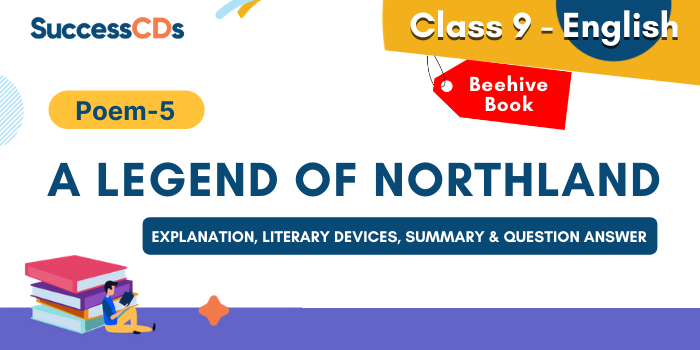
Introduction to the poem
‘A legend of the Northland’ is a ballad. A ballad is a poem narrating a story in short stanzas. Ballad is such kind of poem which tells a story in short stanzas and in the poem all the stanzas comprise four lines. In total, there are 16 stanzas in this poem and these stanzas will tell us a story. Ballads are a part of folk culture or popular culture and are passed on orally from one generation to the next. (Folk culture is a story of any area and is known as ballad). Folk culture comprises of traditional stories which are passed on from one generation to next generation.
This story is of the Northland area, the area which is near the North Pole. This exact place is not specified but ‘Northland’ means the area in the northern most part of the earth i.e., near the North Pole. ‘Legend’ means a historical story, one which is very old and has been passed on from generation to generation.
Poem and Explanation
Stanza 1
Away, away in the Northland,
Where the hours of the day are few,
And the nights are so long in winter
That they cannot sleep them through;
In the region around the North Pole (Northland), the duration of the day is very less because its position is such that the Sun’s rays reach for a very less time. When this area is experiencing winter season, the duration of night is very long, and the day time hours are very less. In line 4, ‘they’ refers to the people who live in this region. The poet says that the duration of the night time is so long that the people cannot sleep them through. If they go to bed, take a few hours of sleep and then, they wake up, it is still night time. He wants to emphasize on the fact that the duration of the night is very long.
Stanza 2
Where they harness the swift reindeer
To the sledges, when it snows;
And the children look like bear’s cubs
In their funny, furry clothes:
Sledges: a vehicle on runners for conveying loads or passengers over snow or ice, often pulled by draught animals.
To harness means to tie the reindeers with a rope to a sledge so that it can be used for transportation.
Swift: something which runs very fast
The Northland region experiences severe cold conditions. It is a snowy area. The reindeer is an animal which is found in this polar region. People tie the reindeers to sledges and then the reindeers pull the sledges. He adds that the children look like young ones of a bear because they wear funny looking clothes made of fur which is like the furry skin of a bear.
Stanza 3
They tell them a curious story —
I don’t believe ’tis true;
And yet you may learn a lesson
If I tell the tale to you.
Curious: strange
In line 1 ‘they’ refers to the parents or elders and ‘them’ refers to the children or the younger generation. The elders of the Northland region tell a strange and interesting story to the younger generation. The poet says that he doesn’t think that the story is true, but if he tells the story to the reader, maybe the reader could learn a lesson from it. The story gives an important message.
Stanza 4
Once, when the good Saint Peter
Lived in the world below,
And walked about it, preaching,
Just as he did, you know,
Saint Peter: an apostle of Christ, a disciple or follower of Jesus Christ
Preaching: to give a religious talk
The story is about Saint Peter. When Saint Peter used to live in the world and went around, giving religious lectures to the people just like all saints do, then an incident happened.
Stanza 5
He came to the door of a cottage,
In travelling round the earth,
Where a little woman was making cakes,
And baking them on the hearth;
hearth: fire place where you do cooking
When Saint Peter was moving around the world, giving religious lectures to the people, he reached the door of a cottage where a small woman was making cakes. She was baking the cakes in the fireplace.
Stanza 6
And being faint with fasting,
For the day was almost done,
He asked her, from her store of cakes,
To give him a single one.
faint: to be weak, famished
As Saint Peter had not eaten anything the entire day, he was very hungry and was feeling weak. So, he went to this woman who was baking cakes and he asked for one cake out of the many cakes that she had baked.
Stanza 7
So she made a very little cake,
But as it baking lay,
She looked at it, and thought it seemed
Too large to give away.
The woman was selfish. She did not give cake from her store. Instead, she started making a very small cake for Saint Peter. She did not want to share her things. But, when she put the cake for baking, she looked at it and thought that this cake was too big to be given to someone.
Stanza 8
Therefore she kneaded another,
And still a smaller one;
But it looked, when she turned it over,
As large as the first had done.
kneaded – to make dough from flour.
The little miser woman thought that the cake was too big to be given away. So, she started making another smaller cake. When she looked at that cake, she again felt that it was as big as the previous one. Again, she was not ready to give this smaller cake to Saint Peter.
Stanza 9
Then she took a tiny scrap of dough,
And rolled and rolled it flat;
And baked it thin as a wafer —
But she couldn’t part with that.
scrap: small amount
The third time, she took a very small amount of dough and rolled it. The poet says that she rolled and rolled to lay emphasis on the fact that she rolled the dough and made it very thin like a wafer and baked it. But she was so greedy that she couldn’t give that thin piece of bread to the saint.
Stanza 10
For she said, “My cakes that seem too small
When I eat of them myself
Are yet too large to give away.”
So she put them on the shelf.
The woman reasoned that, when she ate the cakes, she felt that they were very small but if she had to give them to someone, she felt that they were too big to be given away. She put all the cakes on the shelf of her kitchen and she did not give any cake to Saint Peter.
Stanza 11
Then good Saint Peter grew angry,
For he was hungry and faint;
And surely such a woman
Was enough to provoke a saint.
provoke: cause to get angry
Saint Peter became angry. He was very hungry, he was feeling very weak and the selfish woman was not ready to give him even a small cake. This behavior of the greedy woman angered the saint.
Stanza 12
And he said, “You are far too selfish
To dwell in a human form,
To have both food and shelter,
And fire to keep you warm.
dwell: to live
Saint Peter cursed the woman and said that she was very selfish. She did not deserve to live like a human being. He added that God had given her food, shelter, fire to keep warm but she had become selfish for all the resources she had. She did not want to share them with anybody.
Stanza 13
Now, you shall build as the birds do,
And shall get your scanty food
By boring, and boring, and boring,
All day in the hard, dry wood.”
scanty: very little
boring: make a hole in something with a tool or by digging.
Saint Peter cursed the woman that hence, she would become a bird because she did not deserve the human form. She shall become a bird and just like birds build their houses by boring into the wood and collect very little food by working hard the entire day, similarly, she would also work hard in the dry wood, all day and get little food and make a small place for herself to live in.
Stanza 14
Then up she went through the chimney,
Never speaking a word,
And out of the top flew a woodpecker,
For she was changed to a bird.
As soon as Saint Peter cursed the woman, she did not get a chance to speak for herself because that very moment, she flew up to the roof through the chimney and flew out in the form of a bird. Saint Peter’s curse had converted the woman into a bird.
Stanza 15
She had a scarlet cap on her head,
And that was left the same;
But all the rest of her clothes were burned
Black as a coal in the flame.
scarlet: brilliant red colour
When the woman turned into a bird, at that time she was wearing a red – coloured cap on her head. This cap was there on the bird’s head also, but the woman’s remaining clothes had burned and turned black in colour just like coal.
Stanza 16
And every country schoolboy
Has seen her in the wood,
Where she lives in the trees till this very day,
Boring and boring for food.
country: belonging to the countryside i.e. rural areas
People who live in the country side, even the small children who go to school, seen this kind of bird in the woods. They see that she stays there all day and keeps on digging the wood with her beak, to collect her food. Whenever any child sees this kind of bird, then his elders tell him this story. They say that the bird used to be a woman earlier. She was very greedy and so, she was cursed by Saint Peter and turned into a bird. They get a teaching that they should not be greedy.
Literary Devices in the poem
1. Rhyme Scheme: abcb
2. Alliteration: is the repetition of a consonant sound in two or more close words.
Stanza 1 – that, they, them through – ‘th’ sound is repeating
Stanza 2 – they, the – ‘th’ sound is repeating
look, like – ‘l’ sound is repeating
funny, furry – ‘f’ sound is repeating
Stanza 3 – they, them- ‘th’ sound is repeating
yet, you – ‘‘y sound is repeating’
learn, lesson – ‘l’ sound is repeating
tell, tale, to – ‘t’ sound is repeating
Stanza 5 – woman, was – ‘w’ sound is repeating
Them, the, hearth – ‘th’ sound is repeating
Stanza 6 – faint, fasting – ‘f’ sound is repeating
Stanza 8 – still, smaller – ‘s’ sound is repeating
Stanza 9 – took, tiny -‘t’ sound is repeating
Stanza 10 – seem, small – ‘s’ sound is repeating
Stanza 13 – build, birds – ‘b’ sound is repeating
by, boring, boring – ‘b’ sound is repeating
3. Repetition: any word or sentence is repeated to lay emphasis on it.
Stanza 1 – ‘away’ word is repeated
Stanza 9 – ‘rolled’ word is repeated
Stanza 13, 16 – ‘boring’ word is repeated
4. Enjambment: running lines of poetry from one to the next without using any kind of punctuation to indicate a stop
Stanza 1 – line 3 and 4
Stanza 2 – Line 1 and 2; line 3 and 4
Stanza 3 – Line 3 and 4
Stanza 4 – Line 1 and 2; 3 and 4
Stanza 10 – Line 1, 2 and 3
Stanza 11 – Line1 and 2
5. Simile: Comparison using ‘as’ or ‘like’
Stanza 2 – ‘the children look like bear’s cubs’. Children compared to bear’s cubs
Stanza 9 – ‘baked it thin as a wafer’. Cake is compared to a wafer.
Stanza 15 – ‘clothes were burned black as a coal’. The colour of the burned clothes is compared to that of coal.
Summary
The poem is a legend about an old lady who angered Saint Peter because of her greed. The story goes’ on like this. One day, Saint Peter was preaching around the world and reached the door of a cottage where this woman lived. She was making cakes and baking them on a hearth. St. Peter was fainting with hunger. He asked the lady to give him a piece of cake. The cake that she was baking then appeared to be too big, so she did not give him that and instead, she baked another smaller one. That also appeared to be big so she did not give him that also. The second time she baked yet another smaller cake but found it too big to give away. In the third attempt, she took an extremely little scrap of dough and rolled it flat. She had it as thin as a wafer but was unable to part with that also. This angered St. Peter a lot. He said that she was not fit to live in human form and enjoy food and warmth. He cursed her and transformed her into a woodpecker bird who had to bore in hard, dry wood to get its scanty food. She can be seen in the trees all day boring and boring for food.
Question and Answers
1. Which country or countries do you think “the Northland” refers to?
A. The northland refers to the region around the north pole which is extremely cold. It could be any country like Russia, Canada, Greenland, Norway, etc.
2. What did Saint Peter ask the old lady for? What was the lady’s reaction?
A. Saint Peter asked the lady to give him a cake as he was hungry. The lady did not give him a cake out of the ones that she had baked, instead she baked a smaller one for him.
3. How did he punish her?
A. He punished the selfish lady by turning her into a woodpecker bird that had to bore into the dry wood all day to get some food and shelter.
4. How does the woodpecker get her food?
A. The woodpecker gets food by boring holes in the wood.
5. Do you think that the old lady would have been so ungenerous if she had
known who Saint Peter really was? What would she have done then?
A. If the old lady knew who Saint Peter was, then she would not have been ungenerous. On the other hand, she would have served him well for the fulfilment of her greedy desires.
6. Is this a true story? Which part of this poem do you feel is the most important?
A. It is not a true story. The point of the story where the woman is turned into a woodpecker bird is the most important. This is so because the punishment teaches everyone the lesson to be generous.
7. What is a legend? Why is this poem called a legend?
A. A legend is a popular story from the past which is believed to be true but cannot be verified. It contains a moral which is narrated to the children to teach them moral values.
8. Write the story of ‘A Legend of the Northland’ in about ten sentences.
A. One day, Saint Peter was preaching around the world and reached the door of a cottage where this woman lived. She was making cakes and baking them on a hearth. St. Peter was fainting with hunger. He asked the lady to give him a piece of cake. The cake that she was baking then appeared to be too big, so she did not give him that and instead, she baked another smaller one. That also appeared to be big so she did not give him that also. The second time she baked yet another smaller cake but found it too big to give away. In the third attempt, she took an extremely little scrap of dough and rolled it flat. She had it as thin as a wafer but was unable to part with that also. This angered St. Peter a lot. He said that she was not fit to live in human form and enjoy food and warmth. He cursed her and transformed her into a woodpecker bird who had to bore in hard, dry wood to get its scanty food. She can be seen in the trees all day boring and boring for food.
Grammar Exercises
Let’s look at the words at the end of the second and fourth lines, viz., ‘snows’ and ‘clothes’, ‘true’ and ‘you’, ‘below’ and ‘know.’ We find that ‘snows’ rhymes with ‘clothes’, ‘true’ rhymes with ‘you’ and ‘below’ rhymes with ‘know’.
Find more such rhyming words.
A. The rhyming words in the poem are –
| few |
Through |
|
earth |
Hearth |
|
done |
One |
|
lay |
Away |
|
flat |
That |
|
myself |
Shelf |
|
faint |
Saint |
|
form |
warm |
|
food |
wood |
|
word |
bird |
|
same |
Flame |
Poem 6 – No Men Are Foreign By James Kirkup

Introduction to the poem
The title- ‘No men are Foreign’ means that the no men belong to another country. The poet wants to say that all men are same, all men are equal. He wants to promote the concept of universal brotherhood. In this poem, the poet wants to tell us that everyone in this world is same. All people, all men are same – they eat, live, die the same way. Everyone gets the bounties of nature like, sunshine, land etc in equal measure. We can also say that it is a peace poem.
Poem and Explanation
Stanza 1
Remember, no men are strange, no countries foreign
Beneath all uniforms, a single body breathes
Like ours: the land our brothers walk upon
Is earth like this, in which we all shall lie.
Beneath: under
Strange: unknown
In the first line the poet says that no men are strange, and no country is foreign. So, he is attempting to remove the borders from the Earth which have been erected to separate different countries. Then only no country will be foreign. We will feel every country as our own land when there will be no borders, everyone will be free to move around. The poet wants to say that the entire Earth is one and all the people who live on this Earth belong to one human race. Then he says that inside the uniforms worn by soldiers of different countries, the human being is the same. God has made all of us in a similar way. All breathe in the same way. Then he says that all the soldiers are our brothers – we all walk upon the same ‘Mother Earth’ and upon our death, shall lie in the grave in the same Earth.
Stanza 2
They, too, aware of sun and air and water,
Are fed by peaceful harvests, by war’s long winter starv’d.
Their hands are ours, and in their lines we read
A labour not different from our own.
‘They’ refers to those people who belong to other countries. We call them foreigners and discriminate them and fight with them also. The poet says that nature has given all the bounties to all people also just like he has given to us. Everyone gets sunlight, air and water in equal measure which means that God does not differentiate between people from different countries. We all do farming during the time of peace, when there is no war. We live a relaxed life and eat the things given to us by nature. Further, he adds that the way we starve during wars and winter time is the same for those belonging to other countries. Even they don’t get food at that time. So, he wants to say that foreigners who belong to another country and we, both are same. And then the poet says that even their hands are same as ours, they work very hard just like we do. He is giving all these examples to covey to the reader that there is no difference in us and the people belonging to another country.
Stanza 3
Remember they have eyes like ours that wake
Or sleep, and strength that can be won
By love. In every land is common life
That all can recognise and understand.
The poet asks the reader to remember something. He says that we should keep in mind that the people of another country, whom we think to be our enemies, have been bestowed by God with similar appearance like us. God has given them eyes like ours which open when awake and close when we are asleep. Similarly, he has given them strength which we can win through love. Then he says that in every country, in every land there is one common thing, that is life. Life means all the things that are living. And if we can recognize them and if we can understand their feelings and realize that they are like us, then there will be no fights or wars between us.
Stanza 4
Let us remember, whenever we are told
To hate our brothers, it is ourselves
That we shall dispossess, betray, condemn.
Remember, we who take arms against each other
dispossess: dislodge; deprive
The poet says that we should remember that whenever someone tells us to hate a person from another country, to think him as our enemy, and whenever we think someone to be our enemy, then we deprive ourselves, we cheat ourselves, and we condemn ourselves. He says that we should stay away from such negativity. We should not consider anyone to be our enemy. During a war, both the parties must bear the loss. And that is why the poet says that war is not in our favour. He says that whenever we pick any weapon against someone, we should remember one thing…….
Stanza 5
It is the human earth that we defile.
Our hells of fire and dust outrage the innocence
Of air that is everywhere our own,
Remember, no men are foreign, and no countries strange.
defile: make dirty; pollute
outrage the innocence of: violate the purity of
We should keep in mind that whenever we pick weapons against any person, we make the Earth dirty because weapons kill people and their bodies which fall on the Earth make it dirty. Whenever war happens, it leads to a lot of bloodshed, fire and death. These dead bodies accumulate on the Earth and it make it impure. The fire of war which erupts, the smoke which comes out, the dust which fills the air – it is so dirty that it pollutes and outrages the purity of the air. With all these things the poet wants to give us a message that we should not indulge in war. Finally, he ends the poem by writing the first line in reverse and saying that Remember, no men are foreign, and no countries strange.
Literary Devices
1. Rhyme Scheme – The entire poem is written in free verse. There is no rhyme scheme in the poem.
The literary devices used are as follows –
2. Alliteration: The repetition of a consonant sound in two or more closely placed words is called alliteration. The instances of alliteration in the poem are –
a) Stanza 1 – Body, breathes ‘b’ sound is repeated
b) Stanza 2 – war’s, winter ‘w’ sound is repeated
3. Metaphor
a) Stanza 1 – Uniform refers to the military of different countries
b) Stanza 2 – wars time is compared to the winter season
4. Repetition: It is used in the entire poem.
a) ‘Remember’ word is repeated 5 times in this poem.
b) ‘Remember, no men are strange, no countries foreign’ is repeated in stanza 1 and stanza 5
5. Enjambment – running lines of poetry from one line to the next without using any kind of punctuation to indicate a stop. Instances of enjambment in the poem are as follows-
a) Stanza 1 – line 2, 3 and 4
b) Stanza 2 – line 3 and 3
c) Stanza 3 – line 1, 2, and 3
d) Stanza 4 – line 1 and 2
e) Stanza 5 – Line 2 and 3
Summary
The poem ‘No Men Are Foreign’ begins and ends with the same line- ‘Remember no men are strange, no countries foreign’ as the poet wants to emphasize on the fact that all the people living on this Earth are the same and that we have created distinctions by erecting borders and fences, different languages, etc. While we are alive, we walk on the same Earth and upon our death, we will lie in our graves in the same earth. He draws another similarity that we all enjoy good food during peace and starve during war and in winter time. We all have similar hands which we use to do a lot of hard work. All of us have eyes which remain open when we are awake and close when we are asleep. He reminds the reader that whenever we hate someone, we cheat and hate ourselves. Also, when we pick up weapons against someone, we pollute the Earth and make it impure with the huge mounds of dead bodies strewn on it.
Question and Answers
1. (i) “Beneath all uniforms . ..” What uniforms do you think the poet is speaking about?
(ii) How does the poet suggest that all people on earth are the same?
A. (i) The uniforms refer to those worn by soldiers belonging to different countries who indulge in wars and fights.
(ii) The poet says that all the people are the same in the following ways –
a) we belong to one human race
b) we walk on the same Earth
c) Upon death, we will lie in our graves in the same Earth
d) During peace we all enjoy the bounties of nature
e) During war and in the winter season, we all starve due to shortage of food
f) We all do a lot of labour with our hands
g) We have eyes which function in the same way
2. In stanza 1, find five ways in which we all are alike. Pick out the words.
A. The five words which indicate that we are all alike are –
a) we walk
b) we breathe
c) we have eyes
d) we work with our hands
e) we enjoy the bounties of nature
3. How many common features can you find in stanza 2? Pick out the words.
A. There are three common features in stanza two. They are as follows –
a) We enjoy the bounties of nature and eat good food during peace
b) We starve during war and in winter season.
c) We have similar hands which we use for doing labour
4. “…whenever we are told to hate our brothers …” When do you think this happens? Why? Who ‘tells’ us? Should we do as we are told at such times? What does the poet say?
A. The leaders of any country tell the masses to hate the people of another country. They say so to fulfil their personal gains and benefits. The poet says that we should not follow them because when we hate our brothers, we hate and belittle ourselves. When we indulge in wars, we pollute and render the mother Earth impure by laying dead bodies on it.
Poem 7 – The Duck and the Kangaroo by Edward Lear
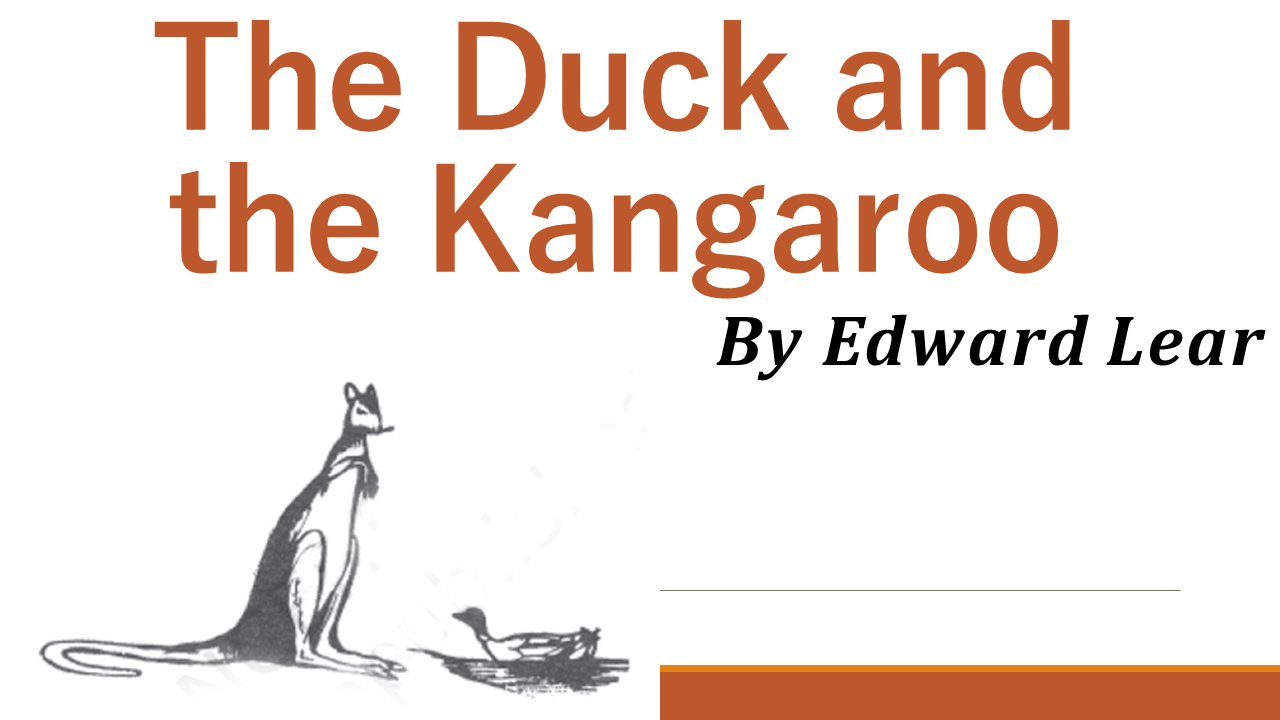
Introduction to the poem
The poem elaborates the desire of a duck confined within the limits of the pond to go beyond and travel the world like the kangaroo did. The duck requests the kangaroo to take it on a trip and find a solution to the problems which the kangaroo would face.
Poem and explanation
Stanza I
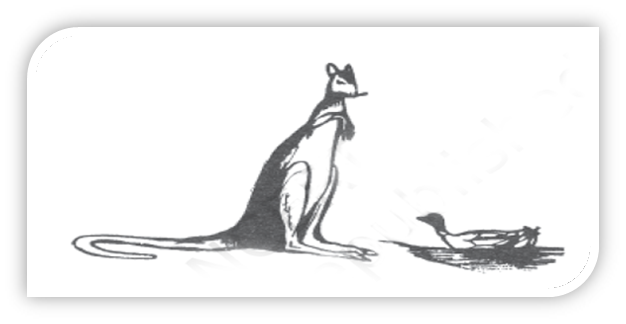
Said the Duck to the Kangaroo,
“Good gracious! how you hop!
Over the fields and the water too,
As if you never would stop!
My life is a bore in this nasty pond,
And I long to go out in the world beyond!
I wish I could hop like you!”
Said the Duck to the Kangaroo.
Nasty: unpleasant, bad
The duck is awestruck to see the movement of the kangaroo. It expressed that the kangaroo could hop continuously over the fields and water bodies. The ducks life was boring as it remained in the pond all the time. It wished to see the world beyond the limits of the pond. It wishes that it could also hop like the kangaroo.
Stanza II
“Please give me a ride on your back!”
Said the Duck to the Kangaroo.
“I would sit quite still, and say nothing but ‘Quack’,
The whole of the long day through!
And we’d go to the Dee, and the Jelly Bo Lee,
Over the land, and over the sea;
Please take me a ride! O do!”
Said the Duck to the Kangaroo.
Quack: sound made by the duck
The duck requests the kangaroo to give it a ride on its back. It promised that it would sit quietly and would just quack all day. The duck lists the places that they would visit as Dee and Jelly Bo Lee. It adds that they would hop over the land and the sea.
Stanza III
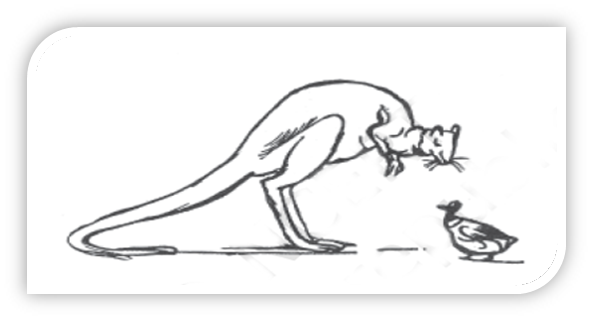
Said the Kangaroo to the Duck,
“This requires some little reflection;
Perhaps on the whole it might bring me luck,
And there seems but one objection,
Which is, if you’ll let me speak so bold,
Your feet are unpleasantly wet and cold,
And would probably give me the roo-
Matiz!” said the Kangaroo.
Reflection: thought, pondering
Roo-matiz: refers to the disease of rheumatism
The kangaroo replied that it had to think over it. The idea could be good for him but he had an objection – that the duck’s wet and cold feet could give it body pains.
Stanza IV
Said the Duck, “As I sat on the rocks,
I have thought over that completely,
And I bought four pairs of worsted socks
Which fit my web-feet neatly.
And to keep out the cold I’ve bought a cloak,
And every day a cigar I’ll smoke,
All to follow my own dear true
Love of a Kangaroo!”
Cloak: shrug
The duck said that as it sat on the rocks during the day, it had thought over it. In order to avoid that, the duck had bought four pairs of worsted socks which fitted its web – shaped feet well. In order to stay warm, it would wear a shrug and also, smoke a cigar every day. The duck would do all this to protect the kangaroo as it was a beloved.
Stanza V
Said the Kangaroo, “I’m ready!
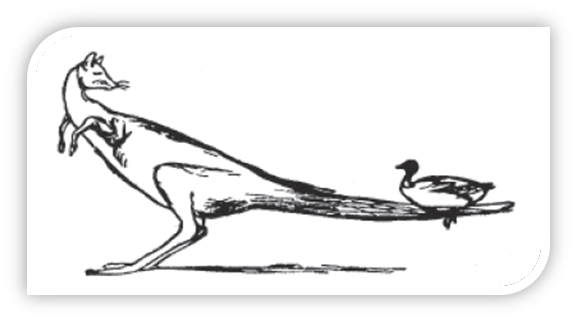
All in the moonlight pale;
But to balance me well, dear Duck, sit steady!
And quite at the end of my tail!”
So away they went with a hop and a bound,
And they hopped the whole world three times round;
And who so happy — O who,
As the Duck and the Kangaroo?
The kangaroo was satisfied with the duck’s response and got ready for the ride. At night, when the sky was filled with the pale light of the moon, they started their trip with a hop. The kangaroo asked the duck to hold it firmly and they travelled around the world three times. Both of them enjoyed each other’s company.
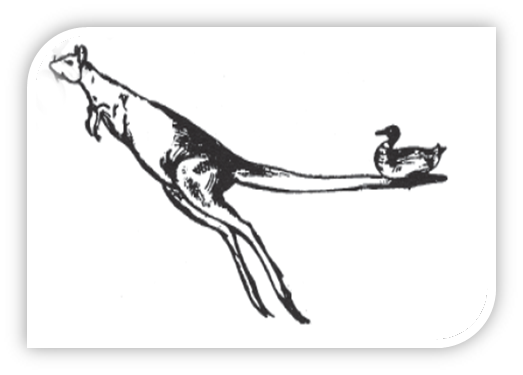
Literary devices
1. Rhyme scheme
Stanza 1 – ababccaa
Stanza 2 – ababccbb
Stanza 3, 4, 5 – ababccdd
2. Alliteration – The repetition of a consonant sound at the start of two or more closely placed words.
a) Good gracious- ‘g’
b) how you hop – ‘h’
c) sit quite still, and say – ‘s’
d) But to balance- ‘b’
e) dear duck – ‘d’
f) whole world – ‘w’
3. Anaphora- When the same word is used at the start of 2 or more consecutive lines.
Instances of anaphora in the poem are as follows –
a) And to keep out the cold I’ve bought a cloak,
And every day a cigar I’ll smoke,
b) And they hopped the whole world three times round;
And who so happy — O who,
Both the pairs of sentences begin with ‘and’.
4. Refrain- the use of a musical rhyming sentence throughout the poem. “Said the duck to the kangaroo” has been repeated to lay stress on the request made by the duck to the kangaroo.
5. Enjambment – When the same sentence continues in two or more lines.
Instances of enjambment in the poem are as follows –
a) “And I bought four pairs of worsted socks
Which fit my web-feet neatly.”
b) “All to follow my own dear true
Love of a Kangaroo!”
Summary
The poem gives an account of a conversation between a duck and a kangaroo. The duck praises the kangaroo for its ability to hop and visit places. The duck finds the pond boring as it has to stay there forever. The duck requests the kangaroo to make it sit on its back and go on a trip to places like the Dee, and the Jelly Bo Lee, crossing lands and seas. It promises that it would remain quiet and would only quack. The kangaroo replies that it will have to think over it because the duck’s wet and cold feet may give it body pains – the disease of rheumatism.
The duck says that it has made arrangements for the kangaroo’s safety. It had got four pairs of worsted socks which fitted the web – shaped feet well. Additionally, it would wear a cloak to save itself from the cold weather and would smoke one cigar a day too. The duck loves the kangaroo and so, wants to take precautions for its well – being. The kangaroo agrees to take the duck on a trip. It asks the duck to sit firmly and not to move.
The duck sits on the kangaroo’s back. The kangaroo starts with a hop and they take three trips around the world. Both of them enjoy each other’s company.
Poem 8 – On Killing a Tree by Gieve Patel
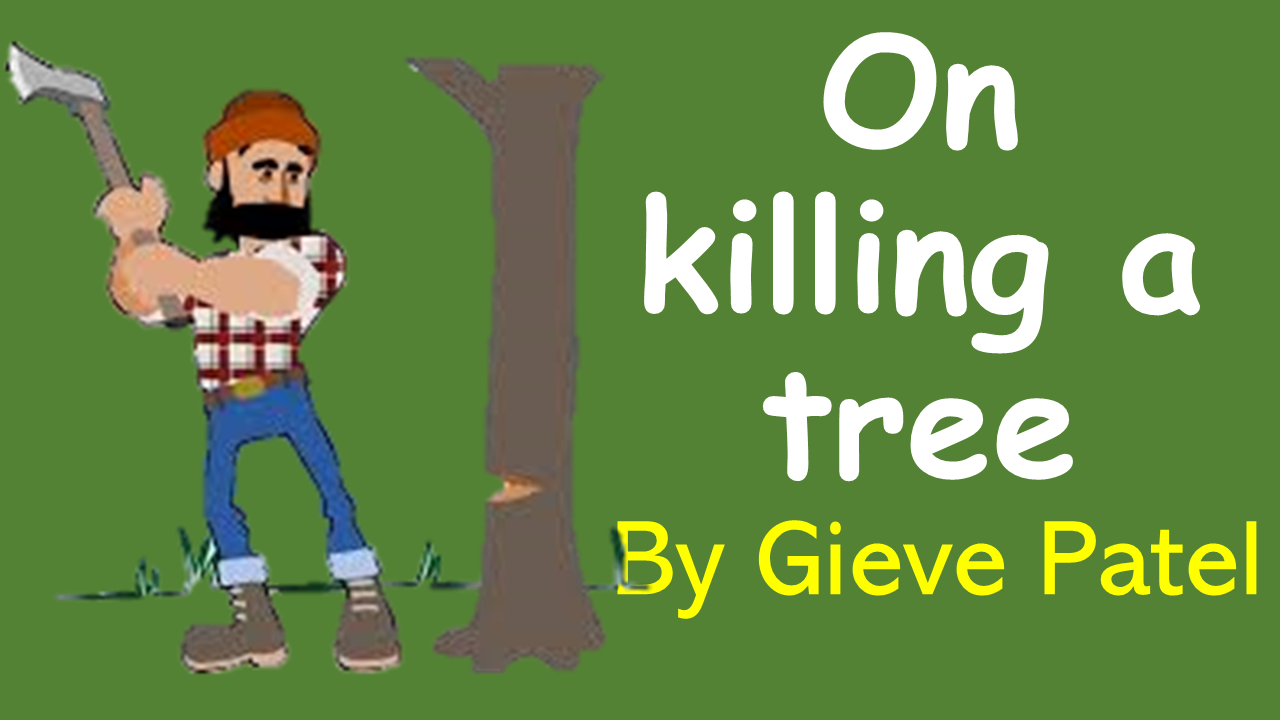
Introduction to the lesson
The poet sensitizes the reader and highlights the fact that trees are living things. He equates trees with humans to convey that trees should not be cut because destroying trees is just like killing a human being. A tree does not die by merely cutting because it regrows from where it is cut. If it has to be destroyed, then it has to be uprooted.
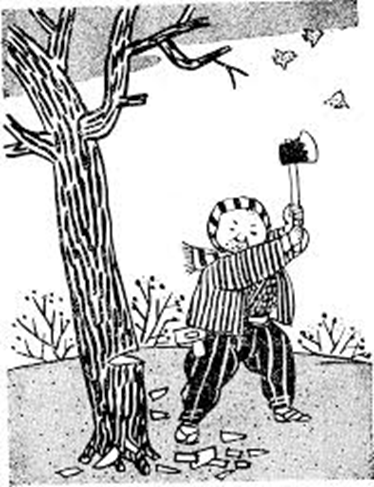
Poem and Explanation
Stanza 1
It takes much time to kill a tree,
Not a simple jab of the knife
Will do it. It has grown
Slowly consuming the earth,
Rising out of it, feeding
Upon its crust, absorbing
Years of sunlight, air, water,
And out of its leprous hide
Sprouting leaves.
Jab: sudden rough blow
Leprous hide: discoloured bark
A simple cut does not destroy a tree. A tree grows gradually, it is rooted in the soil. A plant takes nutrition from the soil to grow into a big tree. The tree is firmly bound with the soil. It takes in sunlight, water and air to grow into a strong trunk and have numerous leaves.
Stanza 2
So hack and chop
But this alone won’t do it.
Not so much pain will do it.
The bleeding bark will heal
And from close to the ground
Will rise curled green twigs,
Miniature boughs
Which if unchecked will expand again
To former size.
Hack: cut roughly by striking heavy blows
Humans cut and chop the bark of trees into many pieces but that is not sufficient to destroy the tree. The point of the tree which gets cut gives out sap just like a human being bleeds. Gradually, this would heals and from there new branches start growing again.
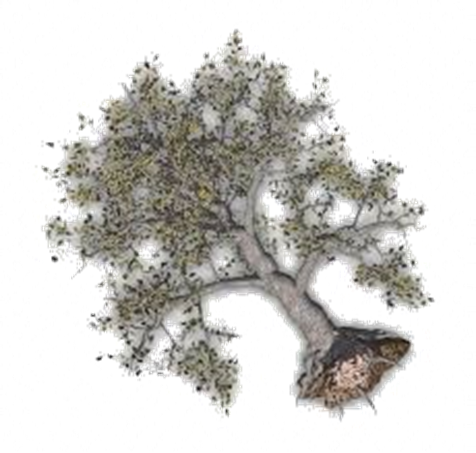
Stanza 3
No,
The root is to be pulled out —
Out of the anchoring earth;
It is to be roped, tied,
And pulled out — snapped out
Or pulled out entirely,
Out from the earth-cave,
And the strength of the tree exposed
The source, white and wet,
The most sensitive, hidden
For years inside the earth.
Anchoring earth: trees are held securely with the help of the roots in the earth
Snapped out: chopped out
The poet says that in order to kill the tree, it has to be uprooted. One has to separate the tree from the Earth which supports it. The roots of the tree bind the tree with the soil in the pit of the Earth. From there, the most sensitive and hidden part of the tree – the roots have to be detached. The roots are white in colour and are damp.
Stanza 4
Then the matter
Of scorching and choking
In sun and air,
Browning, hardening,
Twisting, withering,
And then it is done.
Scorching and choking: the drying up of the tree after being uprooted
Once the tree has been uprooted, then gradually it withers and dries up with the action of heat and wind. The trunk will become brown, twist and will harden. Finally, the tree will die this way.
Literary Devices
1. No rhyme scheme is there in the poem. It is written in free verse. There is no rhyme or rhythm.
2. Enjambment: When one sentence continues into two or more lines.
Not a simple jab of the knife
Will do it. It has grown
Slowly consuming the earth
Rising out of it, feeding
Upon its crust, absorbing
Years of sunlight, air, water,
And out of its leprous hide
Sprouting leaves.
The most sensitive, hidden
For years inside the earth.
3. Metaphor: indirect comparison
Leprous hide – the uneven colour of the surface of the trunk of a tree is compared to the skin of a person suffering from leprosy.
Bleeding bark – the sap coming out of tree where it is cut is compared to the bleeding from the wound in a human’s body.
4. Alliteration: repetition of a consonant sound in 2 or more closely places words.
Bleeding bark – ‘b’ sound
White and wet – ‘w’ sound
5. Repetition: a word or sentence is repeated to lay emphasis on it.
‘Pulled out’ is repeated
Summary
“On Killing a Tree” is a sensitive poem. The poet persuades the reader not to destroy trees and equates it with “killing” a human being. He says that a plant takes sunlight, water, air and nutrients from the soil to gradually become a huge tree. It develops a strong trunk and gets numerous leaves.
Merely cutting the trunk of the tree does not kill it. When a tree is cut, the sap flows out just like a wounded man bleeds. Once the wound heals, new branches and tiny leaves grow from there which grow into trees.
In order to destroy a tree, it has to be uprooted. The roots which are white in colour and are damp due to the moisture that they get from the soil are hidden in a pit in the Earth. These roots are the most sensitive part of the tree as they bind it to the earth. In order to kill the tree, these roots have to be detached from the soil.
Once the roots are detached, the tree starts dying, It withers, dries up with the action of heat and wind, twists, hardens and finally, dies.
Question Answers
1. Can a “simple jab of the knife” kill a tree? Why not?
A. No, a simple jab of the knife cannot kill a tree. The place from where the tree is cut will give out sap and once the wound heals, new branches and leaves will grow from it which will develop into trees.
2. How has the tree grown to its full size? List the words suggestive of its life and activity.
A. The tree has grown by consuming nutrients from the Earth, absorbing sunlight, air and water. The words suggestive of its life and activity are – consuming the earth, Rising out of it, feeding Upon its crust, absorbing years of sunlight, air, water.
3. What is the meaning of “bleeding bark”? What makes it bleed?
A. Bleeding bark refers to the sap which flows out of the tree’s bark where it is cut. The tree bleeds when it is cut with a knife.
4. The poet says “No” in the beginning of the third stanza. What does he mean by this?
A. ’No’ means that the tree will not die by cutting or chopping the trunk.
5. What is the meaning of “anchoring earth” and “earth cave”?
A. “Anchoring Earth” means that the Earth supports the tree firmly. “Earth cave” refers to the pit in the Earth where the roots of the tree bind it firmly to the Earth.
6. What does he mean by “the strength of the tree exposed”?
A. “the strength of the tree exposed” means that upon being uprooted, the most sensitive and important part of the tree i.e. the roots will no longer remain hidden in the Earth.
7. What finally kills the tree?
A. The tree dies when it is uprooted. When it is detached from the Earth, it withers, hardens twists and finally dies.
Poem 9 – The Snake Trying by WWE Ross
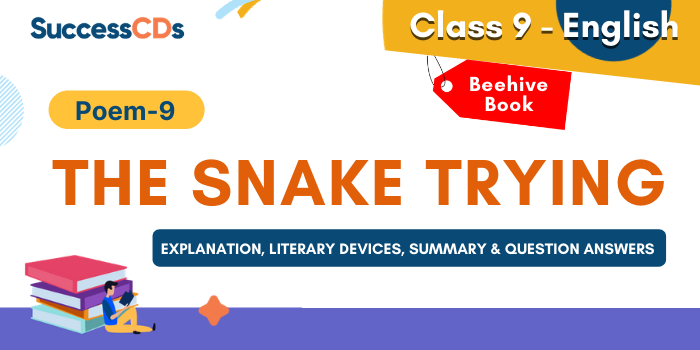
Introduction
In the poem, the poet says that the snake tries to escape from being hit by the stick held by a person who is trying to kill it. The poet wants to say that all snakes are not harmful. Humans have a notion that snakes are dangerous and try to kill them as soon as they spot one but this is not true. He tells us how a harmless green – coloured snake tries to hide behind the green bushes in order to save itself.
Poem and Explanation
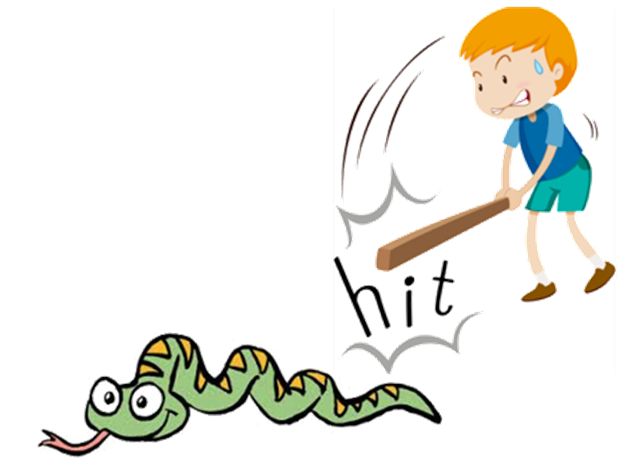
Stanza 1
The snake trying
to escape the pursuing stick,
with sudden curvings of thin
long body. How beautiful
and graceful are his shapes!
Pursuing: Chasing, following
Curvings: Twisting
The snake tries to escape from being hit by the stick that is following it. As the snake crawls, its body twists and turns forming fascinating shapes.
Stanza 2
He glides through the water away
from the stroke. O let him go
over the water
into the reeds to hide
without hurt. Small and green
he is harmless even to children.
Glides: Moves
Stroke: Hitting of the stick
Reeds: Water or marsh plants with thick stems
The snakes moves through the water in order to save itself. The poet pleads to let it escape and hide behind the thick marshy plants as it is harmless. The small green – coloured snake is harmless even to children.
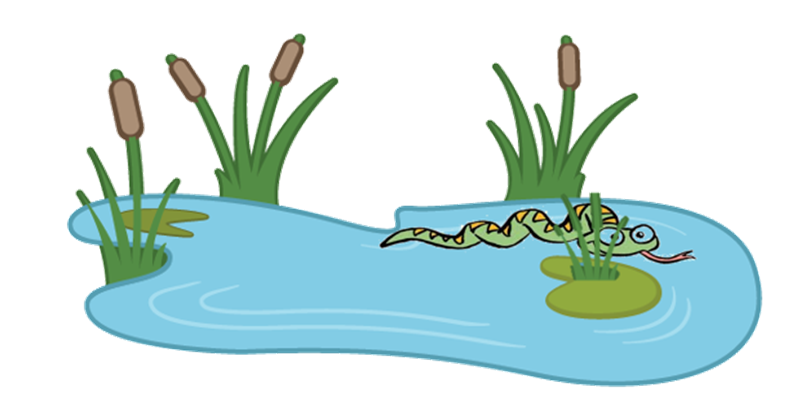
Stanza 3
Along the sand
he lay until observed
and chased away, and now
he vanishes in the ripples
among the green slim reeds.
Vanishes: Disappears
Till it was spotted and chased away by the person holding a stick, it lay quietly in the sand. In order to save itself, the snake disappears in the ripples of the water and hides in the camouflaging green bushes of the marshy plants.
Literary devices
1. Rhyme scheme is absent. The poem is written in free verse.
2. Transferred epithet: the adjective used with a noun refers to a noun other than the one with which it is used.
Pursuing stick – pursuing refers to the person who is holding the stick and not the stick itself.
3. Alliteration: the repetition of a consonant sound in 2 or more consecutive words.
He is harmless – ‘h’
Summary
In this poem, a harmless green – coloured snake tries to save itself from being hit by a person who is chasing it with a stick to kill it. The poet says that the snake is harmless even to children. People fear snakes and when they see one, they try to kill it with a stick. The snake tries to save itself and hides behind the green – coloured bushes of marshy plants growing in the water. It hides in the ripples of the water body in order to save itself. The snake disappears behind the marshy plants.
Question Answers
1. What is the snake trying to escape from?
A. The snake is trying to escape the person who is chasing it with a stick and is trying to hit it.
2. Is it a harmful snake? What is its colour?
A. The snake is harmless. It is green in colour.
3. The poet finds the snake beautiful. Find the words he uses to convey its beauty.
A. The words used to describe the snake are beautiful and graceful.
4. What does the poet wish for the snake?
A. The poet wishes that the snake saves itself.
5. Where was the snake before anyone saw it and chased it away? Where does the snake disappear?
A. Before it was seen, it was lying in the sand. It disappears behind the marshy plants.
Poem 10 – A Slumber did my Spirit Seal by William Wordsworth
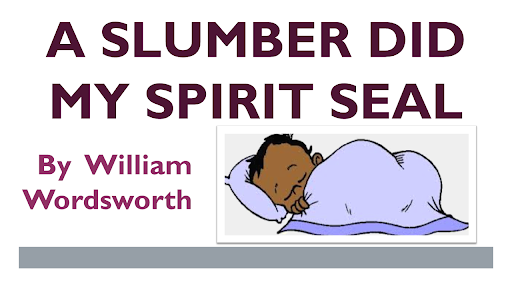
Introduction to the poem
This is one of the ‘Lucy poems’ written by William Wordsworth. These poems have been dedicated to his beloved. The poet refers to death which is a permanent sleep. The poet did not realize when his beloved Lucy slept forever i.e. she died. She had taken life for granted and realized this harsh truth of life after her death.
Poem and Explanation
Stanza 1
A slumber did my spirit seal—
I had no human fears.
She seemed a thing that could not feel
The touch of earthly years.
Slumber: sleep
Spirit: soul
The poet’s soul had drifted into deep sleep as he did not have any realization of the truth. He had taken life for granted and had never thought that one day death would take Lucy away from him. When she was taken away, he could not bear the loss.
Stanza 2
No motion has she now, no force—

She neither hears nor sees,
Rolled round in earth’s diurnal course
With rocks and stones and trees.
diurnal: daily
(Earth’s diurnal course” is earth’s daily rotation on its axis)
The poet accepts the truth that Lucy is no more. She is motionless, lifeless. She cannot see nor hear. She has been buried in the earth. She will assimilate into the earth and is rotating along with the earth. One day she will become one with the rocks, stones and trees that are a part of the Earth.
Literary devices
1. Rhyme scheme – abab cdcd
2. Alliteration – The repetition of a consonant sound at the start of two or more consecutive words is called alliteration. The instances of alliteration are as follows –
‘Spirit sealed’, ‘rolled round’
3. Enjambment – when a sentence continues into two or more lines ending without any punctuation marks, it is called Enjambment. The instances of enjambment are as follows –
“She seemed a thing that could not feel
The touch of earthly years.”
“Rolled round in earth’s diurnal course
With rocks and stones and trees.”
Summary
The poet admits that he was in a sort of a deep sleep because he did not fear the harsh reality of life. He had taken life for granted and had never thought that one day death could separate him from his beloved Lucy. For him she was like an immortal goddess who was unaffected by age and mortality.
As she is dead, she lies motionless. She cannot hear or see. She has been buried in the earth and rotates along with the Earth. One day she will get assimilated with the trees, rocks and stones that are a part of the earth.
Question and Answers
1. “A slumber did my spirit seal,” says the poet. That is, a deep sleep ‘closed off ’ his soul (or mind). How does the poet react to his loved one’s death? Does he feel bitter grief ? Or does he feel a great peace?
A. The poet is full of grief and regret that he had taken things for granted and did not fear the fact that one day death could separate him from his beloved.
2. The passing of time will no longer affect her, says the poet. Which lines of the poem say this?
A. The lines of the poem which say that the passing of time will no longer affect her are as follows –
“She seemed a thing that could not feel
The touch of earthly years.”
3. How does the poet imagine her to be, after death? Does he think of her as a person living in a very happy state (a ‘heaven’)? Or does he see her now as a part of nature? In which lines of the poem do you find your answer?
A. The poet feels that she is a part of nature. As she has been buried in the Earth, she is a part of it and will assimilate with the rocks, stones and trees. The lines which indicate this are as follows-
“Rolled round in earth’s diurnal course
With rocks and stones and trees.”
| Class 9th English Lessons | Class 9th English Mcq | Take Class 9 MCQs |
| Class 9th Hindi Lessons | Class 9th Hindi Mcq | Take Class 9 MCQs |
| Class 9th Science Lessons |